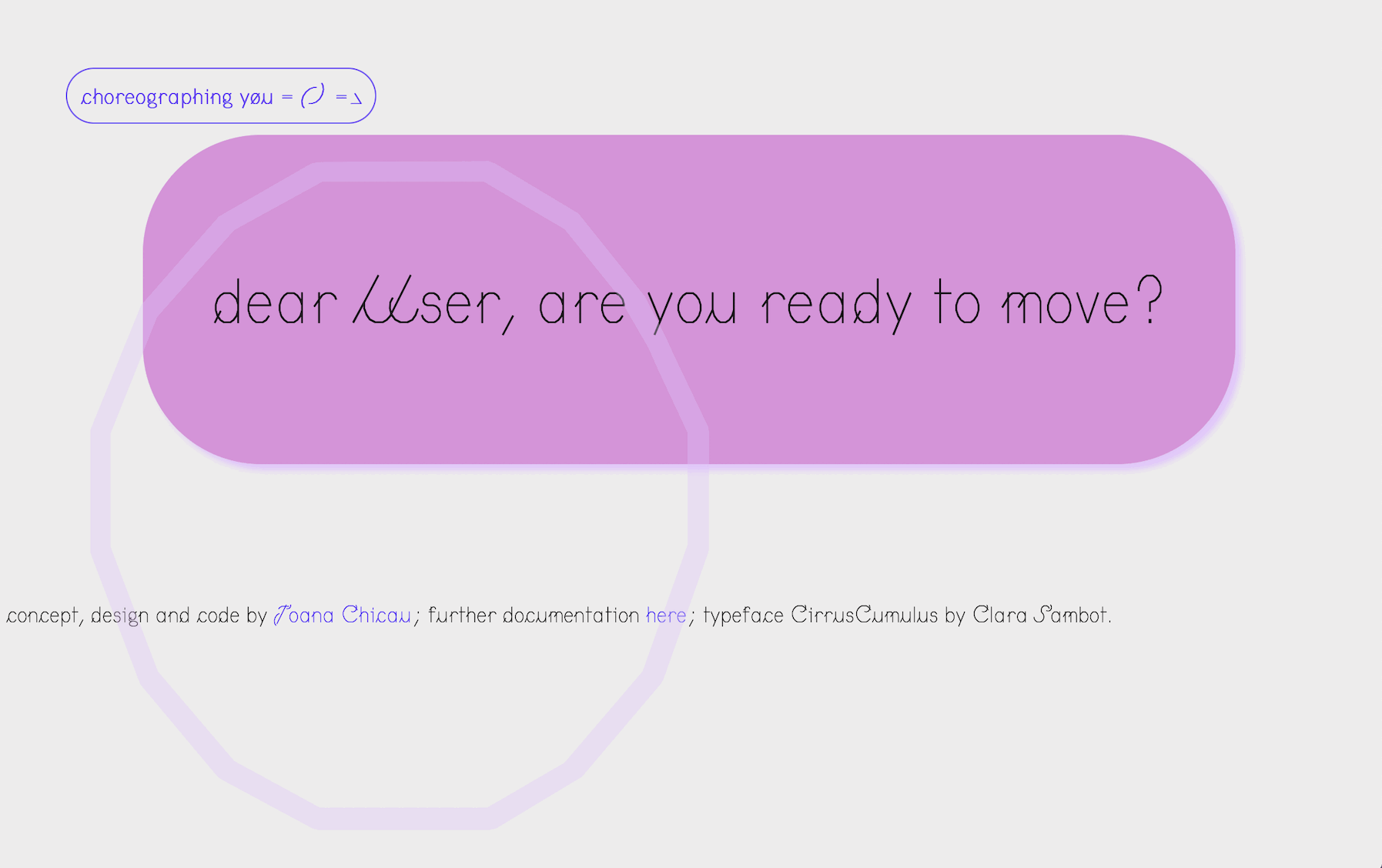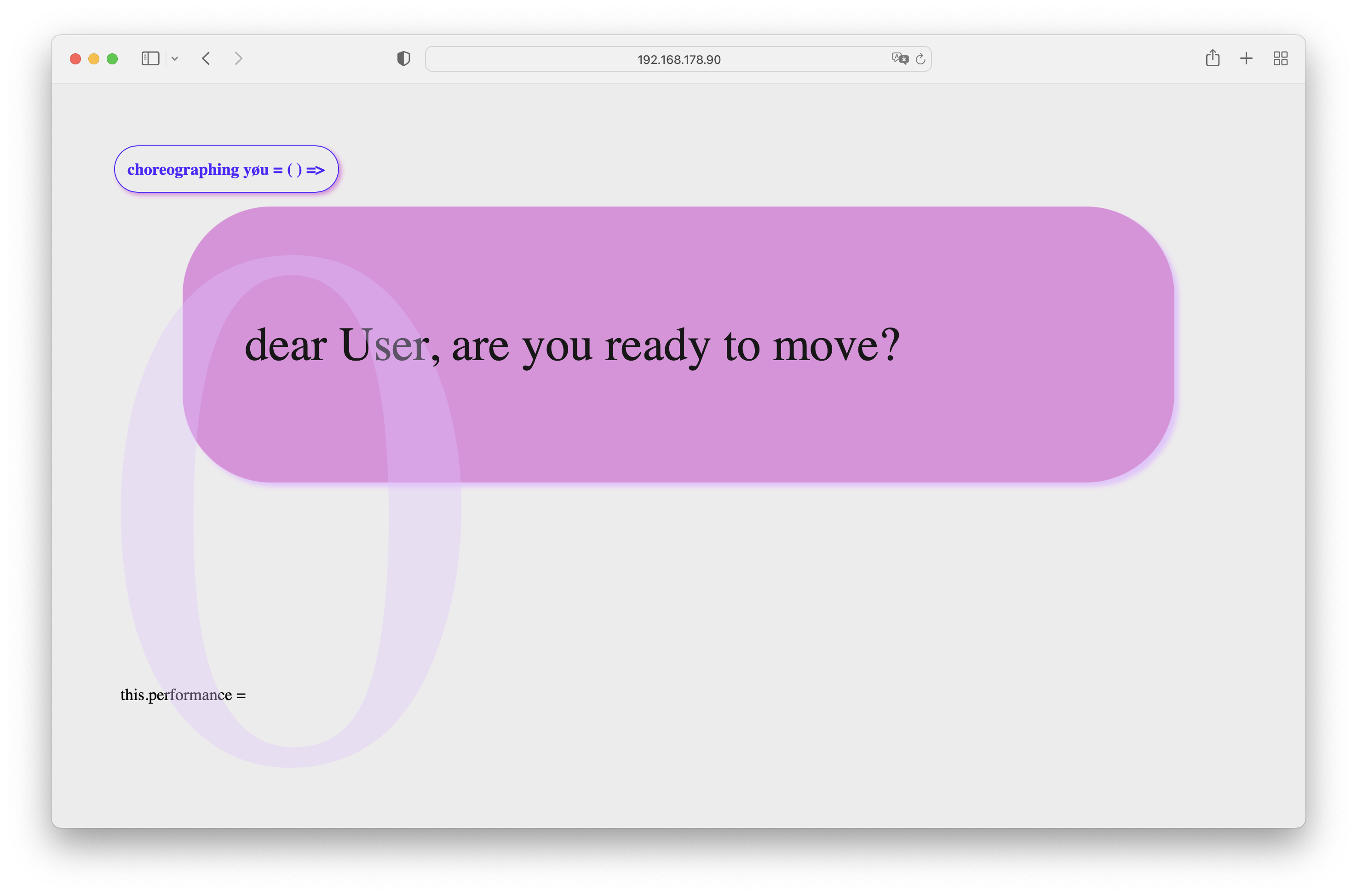Choreographing You
Dear User, are you ready to move?
Algorithmic systems are often designed to be opaque, leaving users unaware of how much of their data is being gathered[1] and for what purposes. There have been a number of reported cases in which algorithmic systems have been responsible for harm and inequality[2] in vulnerable and marginalized communities. One example of this is online tracking algorithms that are present in most web services we access today,[3] though hidden behind user interfaces.
There are various, ever-evolving techniques that enable online tracking. A common one is browser cookies, small pieces of data in plain text format with no executable code that are created by a web server when a user visits a website. Another example is fingerprinting, a tracking technique that collects the settings of users’ web browsers in order to uniquely identify them. Both cookies and fingerprinting are ubiquitous in the ecosystem of the web and usually operate without users' knowledge. Information about users’ online behavior is collected and aggregated to be sold to the ad tech industry, which then provides users with personalized content. This endless feedback loop that has fueled the technological development of the web is driven by corporate interests and surveillance capitalism.
“Choreographing You” takes its title from the book Move. Choreographing You: Art and Dance Since the 1960s, published by MIT Press, which features works from dancers and choreographers who were inspirational to some of the work presented here.
In this context, “Choreographing You” consists of a series of choreographic prompts that combines common metrics from online tracking algorithms with physical enactments. Central to this artwork is the understanding of embodiment as physical engagement grounded in and emerging out of everyday experience.[4] It uses with body-centered approaches to develop an understanding of the actions we perform and the computational systems we interact with.[5]
What would happen if we were paused and breathed deeply every time we clicked? How would that affect our online behavior? Can we retrain our muscle memory to counteract the tracking of our habitual, day-to-day, mundane movements that are linked with tracking?
Twenty-three prompts are presented here as an interactive online display written in HTML, CSS, and JavaScript. These prompts include references to daily movements such as clicking, scrolling, moving the cursor, or idle time. In the interface created, users are invited to click on the “Choreographing You” button, which displays a random prompt while counting and accumulating the clicks made. The aim of the prompts is to draw the user’s attention to the movements they make online and how they are often traced, extracted, and quantified. Finally, the metadata under “this.performance” displays a list of fingerprints, information collected from the user’s browser and device with which the choreographies took place.
This work is an invitation for users to reflect on how different aspects of online presence relate to online tracking. With a touch of humor and absurdity, the choreographic prompts involve the user’s body in an active performance—which, if followed rigorously, may cause a lot of sweat and exhaustion. But aren’t we users already exhausted?

Animated gif of the choreographic prompts on a pink background with a blue button saying “Choreographing You”.
“Choreographing You” draws on a body of work [6][7] and ongoing research into embodied methods and tools for developing and analyzing web-based user interfaces to improve algorithmic awareness, legibility, and user empowerment.
Peers, projects and more:
- Together Net
- Digital Solidarity Networks
- Privacy Not Included by Mozilla
- Data and You by Tactical Tech
- Alternative To
- Design Justice Network zine
- Human Rights Centered Design
Søren Bro Pold, “New ways of hiding: towards metainterface realism,” Artnodes, no. 24 (July 2019): 72–82. https://doi.org/10.7238/a.v0i24.3283 ↩︎
Goda Klumbyte, Phillip Lücking, and Claude Draude, 2020. “Reframing AX with Critical Design: The Potentials and Limits of Algorithmic Experience as a Critical Design Concept,” In Proceedings of the 11th Nordic Conference on Human-Computer Interaction: Shaping Experiences, Shaping Society, (October 2020): 1–12. https://doi.org/10.1145/3419249.3420120 ↩︎
Michael Kretschmer, Jan Pennekamp, and Klaus Wehrle, “Cookie Banners and Privacy Policies: Measuring the Impact of the GDPR on the Web,” ACM Transactions on the Web 15, no. 4 (July 2021): 1–42. https://doi.org/10.1145/3466722 ↩︎
Paul Dourish, Where the Action Is: The Foundations of Embodied Interaction, Cambridge, MA: The MIT Press, 2001. https://doi.org/10.7551/mitpress/7221.001.0001 ↩︎
Scott R. Klemmer, Björn Hartmann, and Leila Takayama. “How bodies matter: five themes for interaction design,” In Proceedings of the 6th ACM conference on Designing Interactive systems (June 2006): 140. https://doi.org/10.1145/1142405.1142429 ↩︎
Joana Chicau. “Choreo-Graphic-Thinking,” Retrieved from https://joanachicau.com/backstage.html (Accessed: August 11, 2023) ↩︎
Joana Chicau and Renick Bell, “Choreographies of the circle & other geometries,” Critical Coding Cookbook, 2022, https://criticalcode.recipes/contributions/choreographies-of-the-circle-other-geometries ↩︎
